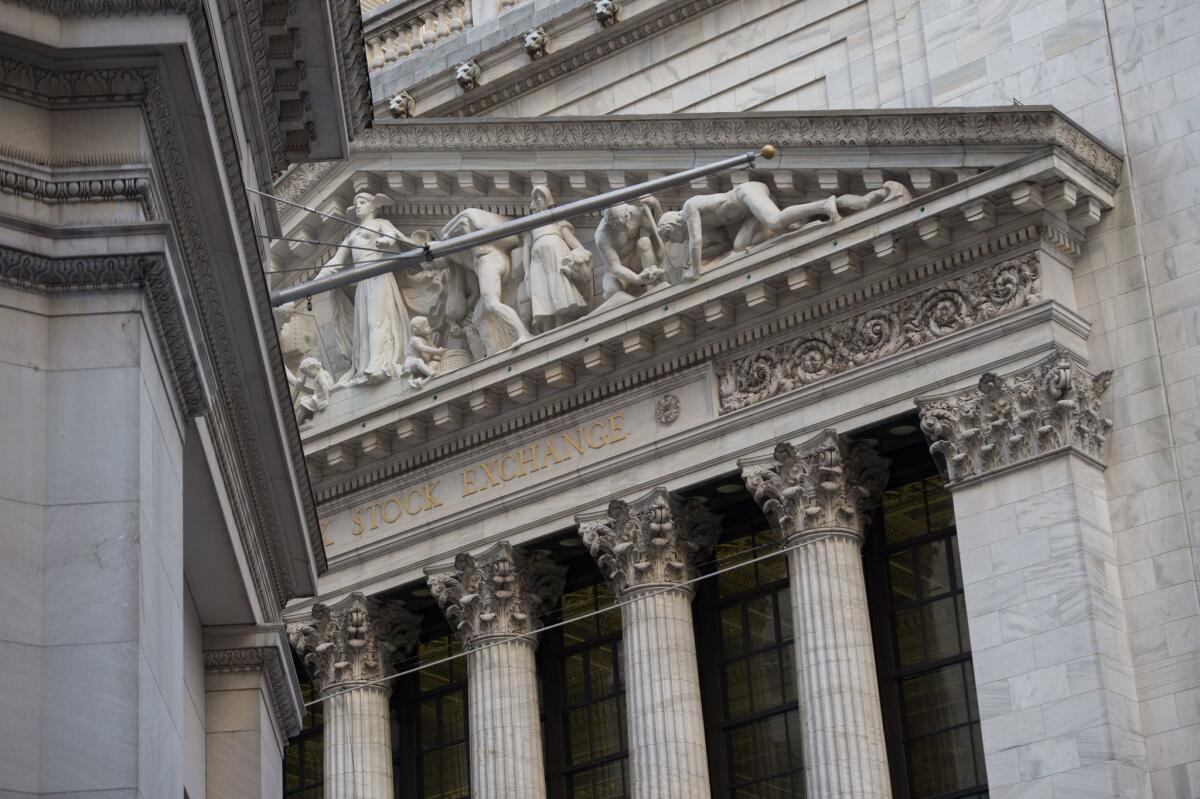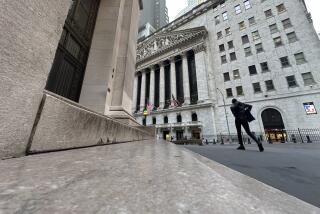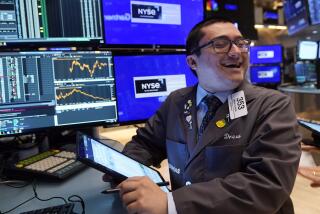Stocks drop, then largely recover, as volatility surges

- Share via
Stocks on Wall Street dropped Wednesday and then recovered, ending the day nearly flat, though the market’s recovery left plenty of signs of worry among investors that the fallout from the U.S.-China trade war will spread.
The early slide briefly pulled the Dow Jones industrial average down more than 580 points, but a late-in-the-session rally erased nearly all those losses. Technology and consumer staples firms powered much of the gains, offsetting declines by banks and energy companies.
Even so, the moves in the bond and commodities markets signaled that investors are nervous that the escalating U.S.-China trade war may derail the global economy.
Bond yields sank around the world, something that happens when investors see a weaker economy and low inflation on the way. The price of oil tanked, and the price of gold shot up to its highest level in six years as traders sought traditionally safe holdings.
“You did see buyers come back to the market, which is a good sign for the market in the near term,” said Lindsey Bell, investment strategist with CFRA Research. “Investors need to buckle in for some volatility here in the next couple of months.”
The Standard & Poor’s 500 index eked out a gain of 2.21 points, or 0.1%, to 2,883.98. It had been down 2% during the heaviest bout of selling.
The Dow ended down 22.45 points, or 0.1%, at 26,007.07. The Nasdaq climbed 29.56 points, or 0.4%, to 7,862.83. The Russell 2000 index of smaller companies slipped 1.40 points, or 0.1%, to 1,500.69.
The market has been roiled the past couple of weeks by growing anxiety as the U.S. and China clash over trade.
Wednesday’s volatility was sparked after central banks in New Zealand, India and Thailand cut key interest rates. The surprise rate cuts triggered a slide in bond yields around the world as investors scrambled for safety.
The yield on the 10-year Treasury touched its lowest level in nearly three years, falling as low as 1.60% from Tuesday’s 1.74%, before climbing back to 1.73%. It was above 3% in late November.
Some investors saw Wednesday morning’s big drops as an opportunity to buy stocks at cheaper prices.
Still, the bond market continues to flash a warning signal of recession. The gap between the yield on the three-month Treasury and the 10-year Treasury widened further.
Investors usually demand bigger yields for tying up their money for longer periods of time, and one rule of thumb says a recession may hit about a year afterward if the gap between those two rates persists.
A three-month Treasury was yielding 0.28 percentage points more than a 10-year Treasury as of Wednesday afternoon. It was 0.36 points earlier in the day — the widest gap since spring 2007, less than a year before the Great Recession began.
Investors are increasingly betting that the Federal Reserve will need to cut short-term interest rates to support the economy given all trade tensions, and traders see a nearly 50% chance of three cuts or more by the end of the year. A month ago, they projected that probability at less than 9%.
U.S. stocks have been on a wild ride since Jan. 22, 2018, when President Trump first imposed tariffs on solar products and washing machines to help U.S. manufacturers, but they’re virtually back to where they started.
The S&P 500 closed at 2,832.97 that day and has since been down as much as 17% and up as much as 7%, with moves often driven by waxing and waning worries about the trade war. The S&P 500 ended Wednesday up 1.8% from that early-2018 starting point.
Since Trump tweeted in March 2018 that “trade wars are good, and easy to win” after raising tariffs on steel and aluminum, the S&P 500 is up 7.2%, though that gain has nearly halved in the last couple weeks as worries about the trade war surged.
Bank stocks sustained some of the biggest losses Wednesday. Lower bond yields mean lower interest rates on mortgages and other kinds of loans, which mean lower profits for banks. JPMorgan Chase shares fell 2.2%.
Match Group soared 24.2% after the online dating company behind Tinder and OKCupid handily beat Wall Street’s quarterly profit forecasts and raised its revenue forecast.
Walt Disney slid 4.9% after the entertainment giant posted disappointing quarterly results, partly on a weak performance from the Fox movie and TV studio.
New York Times declined 12.2% after warning of a decline in quarterly ad revenue.
The dimming expectations for global growth sent the price of crude oil down $2.54, or 4.7%, to settle at $51.09 a barrel. Brent crude fell $2.71 to $56.23 a barrel.
Wholesale gasoline fell 7 cents to $1.62 a gallon. Heating oil declined 7 cents to $1.75 a gallon. Natural gas fell 3 cents to $2.08 per 1,000 cubic feet.
Gold rose $34.90 to $1,507.30 an ounce, silver rose 75 cents to $17.16 an ounce, and copper rose 2 cents to $2.57 a pound.
The dollar fell to 105.69 Japanese yen from 106.52 yen. The euro strengthened to $1.1234 from $1.1200.
More to Read
Inside the business of entertainment
The Wide Shot brings you news, analysis and insights on everything from streaming wars to production — and what it all means for the future.
You may occasionally receive promotional content from the Los Angeles Times.










